1. The Years in Nagasaki
- A Child of the "Civilization and Enlightenment"-
The Takano Family
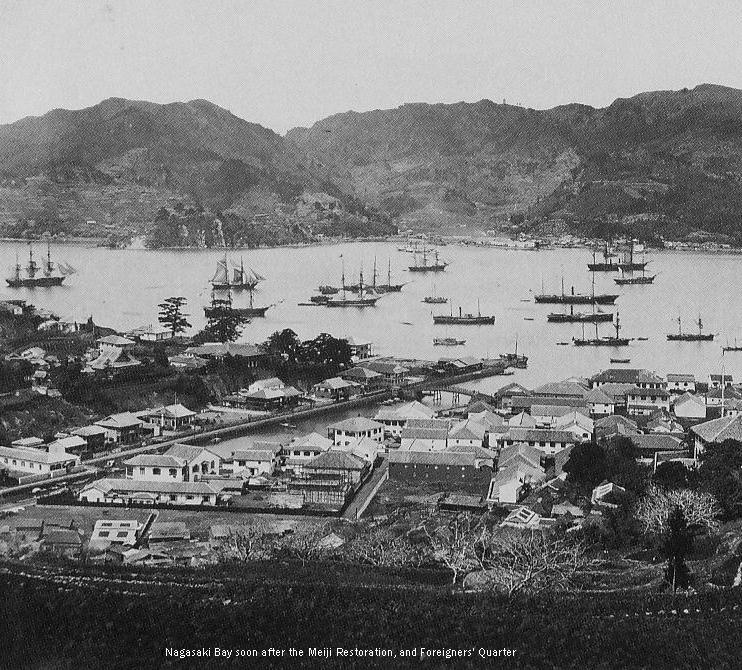
Takano Fusatarô was born January 6th 1869 at Ginyamachi, Nagasaki. He was the eldest son of his father Senkichi and his mother Masu. Until he was ten years old he was called Kyûtarô, but to avoid confusion, from this point on, he was known as Fusatarô.
The Takano family had for generations worked as tailors of Japanese-style clothes. Until the Meiji Restoration the family had been tailors solely to samurai, and by the time of Fusatarô's birth, the family business had grown into a flourishing enterprise with apprentices and craftsmen. His grandfather Iwakichi is said to have been granted the right to a surname and to wear two swords as a samurai. The family was fairly wealthy and besides the family house and property, also possessed woodland and rice fields. Grandfather Iwakichi had died two years before Fusatarô was born, and Fusatarô's family consisted of five people: his parents, his elder sister Kiwa and his grandmother, Iwakichi's widow, Kane.
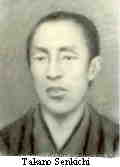 His father Senkichi had been born in 1845 and his mother Masu two years later. Senkichi became a tailor in the family business and succeeded his father as head of the household. He was, however, not the eldest son but the fourth and also had five sisters. The fact that it was the youngest child, Senkichi, who succeeded his father as head of the family suggested that it may have been a family tradition, but after Senkichi's own death, he was succeeded by his eldest son, Fusatarô. It would seem that Senkichi had no choice but to take on the business, as his three elder brothers had all dropped out of it and left Nagasaki. Fusatarô's younger brother Iwasaburô did not remember much about his father, as he later wrote simply : "He succeeded my grandfather, but he was not strong physically and died when he was thirty-nine years old." A photograph of Senkichi survives and also a drawing based on the photograph, but the picture somehow does not leave an impression of a strong character."
His father Senkichi had been born in 1845 and his mother Masu two years later. Senkichi became a tailor in the family business and succeeded his father as head of the household. He was, however, not the eldest son but the fourth and also had five sisters. The fact that it was the youngest child, Senkichi, who succeeded his father as head of the family suggested that it may have been a family tradition, but after Senkichi's own death, he was succeeded by his eldest son, Fusatarô. It would seem that Senkichi had no choice but to take on the business, as his three elder brothers had all dropped out of it and left Nagasaki. Fusatarô's younger brother Iwasaburô did not remember much about his father, as he later wrote simply : "He succeeded my grandfather, but he was not strong physically and died when he was thirty-nine years old." A photograph of Senkichi survives and also a drawing based on the photograph, but the picture somehow does not leave an impression of a strong character."
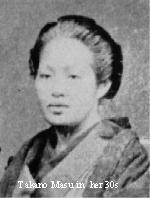 Fusatarô's mother Masu was born April 2nd, 1847, the eldest daughter of rice merchant Yamaichi Yasuhei of Yasakamachi, Nagasaki. Masu's mother's name is given in a later family register as Yasu, but in an older register it appears as 'not known'. It would seem that Masu was parted from her mother when she was very young, either by separation or else by her mother's death, and did not know her mother's name. Takano Iwasaburô wrote in his memoirs;
Fusatarô's mother Masu was born April 2nd, 1847, the eldest daughter of rice merchant Yamaichi Yasuhei of Yasakamachi, Nagasaki. Masu's mother's name is given in a later family register as Yasu, but in an older register it appears as 'not known'. It would seem that Masu was parted from her mother when she was very young, either by separation or else by her mother's death, and did not know her mother's name. Takano Iwasaburô wrote in his memoirs;
She was the daughter of a rice merchant and was an incomparably robust, healthy and strong-minded woman. She had little education but had a firm religious faith in Buddhism. She never tried to force this on her children. We children grew up without getting caught up in the religion of that time. She also had her own convictions that were linked to her faith. She believed that a person simply needed to be sincere; the faith of a pure heart would be heard in heaven.
Takano Iwasaburô's pupil Ôuchi Hyôe, who often visited the Takano household from his student days onwards, recalled: "She was a really spirited woman with a strong character and enjoyed looking after students".
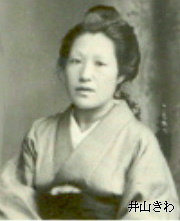 Fusatarô's sister Kiwa, older than her brother two and a half years, was born on August 27, 1866 and seems to have been a hardworking, stout-hearted woman like her mother. His brother Iwasaburô was born two years and eight months after Fusatarô. Iwasaburô would later go on to become a professor at the Imperial University's School of Law, the forerunner of the Tokyo Imperial University's Law Faculty, and later, the Director of the Ôhara Institute for Social Research. After the WWII he was appointed President of NHK (Nippon Hôsô Kyôkai - the Japan Broadcasting Corporation). I myself worked at the Ôhara Institute for many years, and this book was written as a mark of my respect for my esteemed predecessor. I shall be making many references to Takano Iwasaburô in the course of this volume.
Fusatarô's sister Kiwa, older than her brother two and a half years, was born on August 27, 1866 and seems to have been a hardworking, stout-hearted woman like her mother. His brother Iwasaburô was born two years and eight months after Fusatarô. Iwasaburô would later go on to become a professor at the Imperial University's School of Law, the forerunner of the Tokyo Imperial University's Law Faculty, and later, the Director of the Ôhara Institute for Social Research. After the WWII he was appointed President of NHK (Nippon Hôsô Kyôkai - the Japan Broadcasting Corporation). I myself worked at the Ôhara Institute for many years, and this book was written as a mark of my respect for my esteemed predecessor. I shall be making many references to Takano Iwasaburô in the course of this volume.
Birthplace - Ginyamachi, Nagasaki
If you are ever in Nagasaki, it is worth paying a visit to the site of the Takano family home. The location is easy to find. Just downriver from Meganebashi, the oldest and most beautiful of Nagasaki's many stone bridges over the Nakashima River that runs through the center of Nagasaki, is the Fukurobashi Bridge. It is a good spot from which to view Meganebashi. From the left-hand side of Fukurobashi, going up slightly beyond Teramachi street on the mountain side, is a street over seven meters wide and 250 meters long; Ginyamachi is on both sides of the street.
The house in which the Takano family lived at the time of Fusatarô's birth was number 18, Ginyamachi, but in 1966 the numbering system was altered, and most of Ginyamachi was suddenly combined with neighboring Furukawamachi. However, the residents remained strongly attached to the old name and began a campaign to retain it. This was successful, and in January 2007 the old name of Ginyamachi was restored. The current address of the house where Takano Fusatarô lived is 3-15, Ginyamachi, Nagasaki City. The present plot of land has been combined with the neighboring plot, more accurately speaking, the left-hand half of that plot; the site next to the Fukurobashi Bridge is the site of the former Takano home. The plot is in the 'eel's bed' style of Kyoto town houses with a frontage of 24 feet and a depth of 96 feet. It is on the right-hand side, 150 meters from Fukurobashi bridge in the direction of Kôdaiji temple.
It is easy to find because next to it is No. 3-14 Ginyamachi, an address associated with a high profile figure in Nagasaki. The commemorative plaque outside announces it to be none other than the birthplace of Japan's first professional photographer, Ueno Hikoma. Most Japanese, even if they do not know his name, will have seen his photograph of Sakamoto Ryôma, the famous samurai leader from the time of the Meiji Restoration in the 1860s. It is thanks to Ueno Hikoma that we have so many photographs of personalities and scenes from that dramatic period in Japan's history as the long feudal era came to an end and the country opened itself to the world, a period that included the Satsuma Rebellion. Ueno's brother Sachima was also a photographer; he opened a studio in Kôbe, where he trained many pupils. He later moved to Tokyo, and his eldest son Ueno Yôichi was a pioneer in labor management studies in Japan. A graduate of the Psychology Department of Tokyo Imperial University, he was the first to address himself to the problem of industrial efficiency in Japan. In 1922 he established the Industrial Efficiency Research Institute and later founded the Industrial Efficiency College. Just a few houses in the small area of Nagasaki-Ginyamachi, an area that dated back less than 150 years earlier, were the home ground of Takano Fusatarô, his brother Iwasaburô, and of Ueno Yôichi, three of the leading figures in Japanese labor studies.
In the Nagasaki in which Takano Fusatarô was born and grew up, the atmosphere of the previous Tokugawa period (1603-1868) was still very much present. There was still a wooden gate at the entrance to Ginyamachi (as in Edo - old Tokyo), which was shut at night. Flagstones were laid down the center of the street, and Kawaji Toshiakira, the Shogunate's representative in negotiations with Russia, was struck by these to write: in the street flagstones have been laid on both sides, 3 shaku wide (nearly 3 ft). Excellent. Even after Edo was renamed Tokyo, most roads were unsurfaced, and were known for becoming like muddy fields in rainy weather.
Fusatarô's birthday
The day, month and year of a birth is the first thing to establish in any biography, but in Takano Fusatarô's case there is no research of the date. Many accounts, from textbooks to biographical dictionaries, record it as 1868, but this is an error which is based on the assumption that the first year of the Meiji era was 1868. As Japan at that time was still using the lunar calendar, 1868 in the western calendar began on December 7th in the 3rd year of the Keiô era and ended on November 11th of the first year of the Meiji era. Consequently, as Fusatarô's birthday was November 24th of the first year of Meiji, it was on January 6th, 1869.
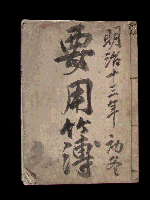 Fusatarô's birthday on November 24th of Year 1 of the Meiji era was clearly recorded as a significant event for the family in the 'register of important matters' (Yôyôbo). This was definitely recorded according to the old calendar. We know this because the entry for Takano Fusatarô in the Great Japan Dictionary of Names (Dai-Nippon jinmei jisho) was written by his brother Iwasaburô, and Fusatarô's birthday was recorded as December 24th of Year 1 of the Meiji era. Recording the date as Dec. 24th rather than Nov. 24th is not an error. The people of those days, when calculating a date from the old calendar into the new calendar, would use the simple method of 'adding a month'.
Fusatarô's birthday on November 24th of Year 1 of the Meiji era was clearly recorded as a significant event for the family in the 'register of important matters' (Yôyôbo). This was definitely recorded according to the old calendar. We know this because the entry for Takano Fusatarô in the Great Japan Dictionary of Names (Dai-Nippon jinmei jisho) was written by his brother Iwasaburô, and Fusatarô's birthday was recorded as December 24th of Year 1 of the Meiji era. Recording the date as Dec. 24th rather than Nov. 24th is not an error. The people of those days, when calculating a date from the old calendar into the new calendar, would use the simple method of 'adding a month'.
For example, Iwasaburô's birthday is recorded in the family register as September 2nd, Year 4 of Meiji, but the curriculum vitae he submitted to the Tokyo Imperial University gives it as August 2nd, Year 4 of Meiji. In other words, although he was born on August 2nd, Year 4 of Meiji, the family register recorded the date of his birth as a month later; September 2nd. Consequently, although most books give Iwasaburô's birthday as September 2nd, Year 4 of Meiji (1871), it was actually August 2nd Year 4 of Meiji in the old calendar, or September 16th, 1871 in the solar calendar.
Japan announced the official commencement of its use of the solar calendar on November 9th, Year 5 of Meiji, or December 9th, 1872. In changing from the lunar to the solar calendar, December 3rd, Year 5 of Meiji became January 1st, Year 6 of Meiji (1873). Units of time in the day were also changed from the 'variable method' (futeijihô), that is, the system in which the length of the day varied with the rising and setting of the sun in accordance with the changing seasons, to the 'invariable method' (teijihô), in which one hour is always 60 minutes and a day is always 24 hours.
With this, the ordering of days, months and years and the measure of hours by which people's daily lives were ruled, was abruptly changed with an advance notice of just three weeks. Naturally, they were unable to adjust to this immediately. But the movement for 'Enlightenment and Progress' (Bunmei kaika), in just one edict, forced convulsive changes in patterns of living that had had a long history behind them. The Takano brothers grew up in the midst of this social, cultural and lifestyle revolution. They really were 'children of the Meiji Era', 'children of the era of "Enlightenment and Progress (bunmei kaika)"'.
Was the Takano family poor?
Takano Fusatarô's interest in the labor movement is sometimes attributed to the poverty he experienced in his youth, and to shed light on the question of his family's economic circumstances when he was growing up is certainly an important topic of research, because it has a bearing on his motives for becoming a labor activist. But from the various sources of evidence available, it can only be concluded that the Takano family was in fact fairly prosperous.
However, although I came to this conclusion, a nagging doubt bothered me, namely, that tailoring is a job in which clothes are made and then a price is asked, which means that however much one works, the profit does not amount to much. I thought about this from various perspectives and in the end concluded that the only way to get to the bottom of it was by a market survey. In other words, I should look into the lifestyles and numbers of samurai in the Nagasaki region at the end of the Tokugawa shogunate and thus investigate the environment in which the Takano family of tailors were running their business.
During the period of Japan's isolation, Nagasaki occupied a special position, as it had a virtual monopoly of Japan's trade with the rest of the world. There were exceptions to this monopoly, such as the Tsushima clan's trade with Korea and the Satsuma clan's trade with the Ryûkyû islands, but the only officially recognized port in which foreign ships were allowed to dock was Nagasaki. Imported goods were sold on at many times their original selling price, and the enormous profit on these goods made Nagasaki as a whole very prosperous. At the top of the Nagasaki tree was the magistrate (bugyô), whose income was enormous. In addition to his official magistrate's income of 1000 koku, he was also entitled to add an official commission of 4000 hyô (1hyô=1koku = 52.5 kg), to his hereditary stipend. Furthermore, he received 'donations' and gifts from the Chinese, Dutch and local Nagasaki traders and above all, he had the right to procure imported goods tax-free, all of which gave rise to exorbitant profits.
Two thousand local officials directed local government and oversaw the city's trade and all of them had wealthy lifestyles. At the end of 1853, Kawaji Toshiakira, the Shogunate's representative in negotiations with Russia, recorded in his Nagasaki Diary (Nagasaki Nikki ) that his accommodation and base while in the city was the home of a local official with a stipend of less than 20 koku, but his house "seemed like the home of an official worth more than 3000 koku". Kawaji also noted "today I passed some houses belonging to city elders and was surprised to see they were like the houses of a daimyô".
There were also many samurai in Nagasaki who had been sent there by clans in other parts of Japan. Many were appointed to police and defense duties in the port of Nagasaki. The Fukuoka and Saga clans each sent 1000 men a year in rotation for this purpose. Many clans opened their own offices and warehouses in Nagasaki for trade and information-gathering and appointed a kikiyaku (literally 'listening official'), responsible for the clan's diplomatic affairs. Many young men were also drawn to the city to study rangaku ('Dutch learning' = Western sciences) and medicine. Nagasaki may seem to have been a city of townspeople and merchants, but in fact, more samurai lived there than in many other castle towns.
For samurai, clothes were an extremely important means of showing one's status and rank. Kawaji Toshiakira was a man who valued modesty, but his diary shows in detail that whenever he met someone, he was very conscious of what they were both wearing. An important consideration for a samurai, indeed one of his accomplishments as a samurai, was correct dress at specific times and places, and admonishments to this effect were often recorded.
Nagasaki was also known as an ultra-fashionable city, and during the Edo Period, the following ditty was often sung:
Kyoto girls and Nagasaki fashions,
With a cheerful Edo spirit,
Looking for fun in an Osaka brothel -
That's the mark of a man who knows life's pleasures
The high value placed on 'Nagasaki fashions' is evident from this song that expresses a popular view of 'a man's ideal pleasures'. Samurai who came to Nagasaki to conduct negotiations with other clans and to get information wanted clothes made of imported materials; we can be fairly certain that this was a reason for the prosperity of the Takano family.
I finally realized that there was an important key to solve the question of the wealth of the Takano family, namely, that they were not simply a family of tailors; Iwakichi's sons were dealing in imported clothing materials. One of the main imported items in Nagasaki was textiles from various parts of the world: cotton fabrics such as calico, muslin, chintz; woolen material such as twilled cloth and goro (from Dutch 'grofgrein'=coarse fabric), and special fabrics such as velvet. In the 1860s and 1870s the main imported items in Nagasaki's trade were ships and warships, but next in line were textiles which amounted to some 20% of total imports. As the Takano family was carrying on its tailoring business in this kind of environment, it certainly had access to imported textiles through various routes. Of course, a large part of the Takano family business consisted of tailoring with these imported materials, but as it was much more expensive for such materials to be bought and sold elsewhere, samurai who wanted their clothes tailored by Takano would at the same time also order material from Takano as presents for people in their local fiefdoms.
The men who governed Nagasaki, on the other hand, from the city magistrate to the local officials were in the position of being able to procure such imported goods tax-free. However, it certainly would have been beneath their dignity to deal in imported goods directly. This is where the bespoke tailors came in. They served as the clients for both the buyers and sellers of imported fabrics and were in the prime position of middlemen between both parties.
There is a fact which is hard to account for unless one assumes that the Takano family were engaged in just this kind of business in imported textiles. The first three of Iwakichi's four sons, including the one who was originally to succeed him as head of the family, all abandoned the family business and moved to the newly opened ports of Yokohama and Hakodate. It is hard to imagine that a craftsman brought up within a family tradition of craftsmen handed down from one's forefathers would suddenly decide to leave home and set up in business in another town. It would be another matter, however, if the person in question had already been dealing in imported goods. With the opening up of the country to foreign trade, a young man who got to know of the great commercial opportunities now available in the newly opened ports of Hakodate and Yokohama would all too naturally be attracted to moving there. Iwakichi would have recognized his sons' desires and would have provided them with the capital necessary to start up in business in a new, unknown city.
In short, the Takano family were not just tailors working for cash in hand; they built up their wealth by dealing in imported textiles. This idea solves the two riddles concerning the Takano family; the source of the wealth and the reason why Fusatarô's three uncles abandoned the family business and all of them left Nagasaki.
'A wild and free spirit'
Takano Fusatarô grew up in Nagasaki until he was nine years old. It is a time in one's life that often leaves many memories, but Fusatarô himself wrote nothing about how he grew up. The only source is the book by his brother Iwasaburô - "My Brother, Takano Fusatarô" (Ani Takano Fusatarô wo kataru).
He spent his earliest years in Nagasaki City, and having grown up there later turned out to have much to do with my brother's campaigning activities. Nagasaki was under direct shogunal control and was a relatively free place. There were only the shogunal officials and the townspeople; there was no clan lordship. It was a free and broadminded place, just like the old free cities of Germany. Moreover, as it was a trading port, it was a town with an international atmosphere, where foreigners were a common sight. My brother was influenced by this environment and grew up with a wild and free spirit.
It certainly was "a town with an international atmosphere, where foreigners were a common sight." In 1882 it numbered some 7000 households and a population of 40,000, of whom 829 were foreigners. The great majority were Chinese (just over 600); the next largest group were the English (90), then 33 French, 32 Americans, and with some from Holland, Switzerland, and Russia, there were people from various countries living there. There were always foreign vessels in the harbor, and their foreign crews and passengers were all too conspicuous. Although young Fusatarô himself may not have had a chance to exchange words with any of the foreigners, the people of Nagasaki were not afraid to have contact with them nor were they prejudiced against them. One can well imagine that, growing up in such a place might stimulate a desire in the young Fusatarô to go abroad himself one day.
It is also true that as a town under direct shogunal control, Nagasaki was a relatively free place. The ruler of the town was the magistrate, who was appointed for a fixed term only. Their careers depended on their jurisdiction not causing any trouble for the central shogunal authorities in Edo, so they avoided behaving like the wicked and tyrannical old governors in historical dramas. Unlike the many clan fiefdoms which had to live on nothing but the produce of their own lands, Nagasaki was a wealthy town in which the profits from trade were spread amongst the populace. Furthermore, as the administration of the town was also the responsibility of the locally-based officials, it was indeed probably a 'free and broadminded place'. However, to claim that someone who grows up in a town with 'a free and broadminded atmosphere' will necessarily grow up to have a 'wild and free spirit' is not exactly logical, although someone who grows up in a town with such an atmosphere might well be imagined to take up an oppositional stance when faced with an oppressive system.
What is important in Iwasaburô's description of his brother is the phrase 'my brother had a wild and free spirit'. Quite apart from intellectual conclusions such as: this was because Nagasaki was not a castle town, we can assume that Iwasaburô's statement is accurate simply because it was an observation made by a brother about a brother. As the eldest son of a wealthy family, he most likely had an easy upbringing.
It is a Japanese characteristic to allow children to be as self-indulgent as they like. In Christian countries there is the tendency to see human beings as 'children of sin' who bear the mark of original sin and who must be strictly disciplined, especially in childhood. This is in effect based on the notion that human nature is evil. In contrast, the Japanese view is that children are as pure as snow and only gradually, as they grow up, do they become stained with the wickedness of this world. Even Japanese Christians think this way. It is only natural that such religious and cultural differences have an effect on child-rearing. Many foreigners have noticed this Japanese characteristic in the way children are treated. Willem Huyssen van Kattendijke, a Dutch instructor who was teaching navigation at the Naval Training School in Nagasaki at the end of the Tokugawa period in the 1860s, has left the following observation:
in general, parents are very loving towards their children, and that loving attitude can be observed throughout the social spectrum, irrespective of rank and whatever the circumstances of the family. The closer one looks, the more it seems that this love can be described as indulgent dotage. The children are certainly very sweet and this innocence is most becoming in little children. I believe it to be the result of the manner in which the parents treat their children. They take good care of them and let them play very freely and if it is not too cold, they allow them to run about in the street almost naked. I have hardly ever seen a parent tell off children for making too much noise. Neither have I seen any adults scolding or punishing their children. In all likelihood, Japanese children are the most bothersome in the world; the boys are the naughtiest little scamps but one will not see such cheerful and happy children in any other place. (My Days at the Naval Training School in Nagasaki).
In Japan there is an old saying: "One can't win against a crying child and the lord of the manor". The young Fusatarô doubtless also enjoyed such an upbringing.
The standard of living of the common people in Nagasaki was high; they were known for their love of life's pleasures, and in Nagasaki, these were very many. They included kite flying at Mt. Kazagashira and Tôhakkei in spring, Peron (dragon boat) racing and floating lanterns at the Bon Festival in summer, and the Okunchi festival at the Suwa shrine in autumn. The Bon (summer) and New Year holiday periods were long, and Kattendijke noted that the year's end and New Year break at the Nagasaki Ironworks lasted two weeks. The first day of the new year in 1858 fell on Feb. 14th according to the new calendar. All work stopped eight days before New Year's Day and restarted a week later. It is apparent from their clothes in surviving photographs that the Takano family were in the habit of enjoying their lives to a greater degree than was normal in the rest of Japan at that time.
An Inborn Love of Studying
In addition to being born into a family that made the most of its pleasures, Fusatarô and Iwasaburô benefited from another aspect of growing up in Nagasaki. They both loved studying and had considerable linguistic ability. We shall return to their love of study later and focus now on their linguistic skills.
Iwasaburô was adept at English and German and during his years as Director of Ohara Institute for Social Research, he often corrected errors in translations made by his colleagues. His wife was German, and both Japanese and German were spoken in their family home. However, in his case, he received a thoroughgoing education from elementary school through to postgraduate school and also spent more than three years abroad as a government-sponsored student, so it is not so surprising that his linguistic skills should have been good.
Fusatarô's English education, on the other hand, was short-lived and irregular. His only formal English instruction was at night school at the Yokohama School of Commerce and on the Limited course of San Francisco Commercial High School. Besides this, he had some private lessons in English writing but only for a very short time, so the total period of study was no more than four or five years - two or three years in Yokohama and one in San Francisco. It is not easy for a Japanese to master a foreign language. I myself have had to spend a long time learning English, from regular classes at junior high school through university, English lessons on radio and TV, English conversation school classes and almost four years living abroad in total. It was not that I was poor at English; on the contrary, it was one of my favorite subjects at school, and yet, when it comes to expressing my own ideas in English, I still have to struggle, and my English is still not at a really practical level.
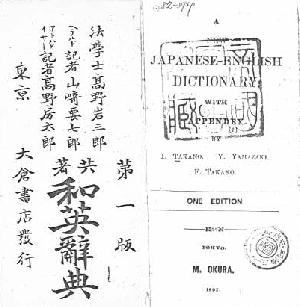 In the light of my own experience, by comparison, Fusatarô's skills in English were at an almost incredibly high level. For example, soon after his return to Japan, he produced a Japanese-English dictionary and a book of English-Japanese business conversation - material proof of the consummate level of his English ability.
In the light of my own experience, by comparison, Fusatarô's skills in English were at an almost incredibly high level. For example, soon after his return to Japan, he produced a Japanese-English dictionary and a book of English-Japanese business conversation - material proof of the consummate level of his English ability.
Also noteworthy are his English-language articles written for American labor union journals. A higher level of English ability is normally required for the writing of essays than for reading and conversation. Yet Takano's essays were published with hardly any correction by the editors. Of course, he did spend ten years of his youth abroad, but mere length of residence in a particular foreign country does not guarantee skill in expressing oneself in the language of the country, especially writing. Takano's ability clearly surpassed that of Katayama Sen, who had lived in America longer and had been through the school system there.
Why then, was Takano so adept at English? He certainly put much more effort into his studies of the language than would most people, but in the end it is most likely that his linguistic abilities were a natural gift. As with music and sports, linguistic ability is an area in which inborn talent calls the tune. One can only think that his English ability was the result of an unusual natural endowment. Why did brothers with such prodigious interests in study and linguistic skills emerge in a family of tailors not noted for any previous scholastic achievements? In my view, this must be related to the fact that they were born and brought up in the especially stimulating town that was Nagasaki.
During the period of Japan's isolation, Nagasaki was the only port that was allowed to have relations with foreign countries. Those who were most directly engaged in facilitating this economic and cultural exchange with foreigners were the interpreters. This was a family business; there were some 70 families specializing in Chinese and 38 families in Dutch. The number of people involved fluctuated over time, but there were at any one time on average about 200-300 interpreters for Chinese, and around 150 for Dutch. Naturally, not all of them were equally good at interpreting. Engelbert Kaempfer, a doctor for the Dutch East India Company's office in Nagasaki, who came to Japan in 1689, recorded his acerbic estimate of his Japanese interpreters:
These interpreters are for the most part extremely crude fellows who with difficulty combine foreign words in an often incoherent manner, and their linguistic ability is such that they are only able to pronounce words in their own dialect and after their own fashion, so that one often has no idea what they are trying to say and often needs another interpreter just in order to be able to speak to the interpreter (The Japan that Kaempfer Saw).
Over the course of time, however, the interpreters' linguistic abilities steadily improved, one reason for which was the implementation of a training system. Another important factor was the increase in the number of people with the ability to study foreign languages. Interpreting was a family business, but as it was a job where what counted was actual ability, there were many cases in which the inheritance went not to the natural-born son but to a talented student. Into these families were also born many well-esteemed scholars of Dutch learning and medicine. For example, Narabayashi Chinzan, who died in 1711, trained several hundred apprentices, while Yoshio Kôgyû, who died in 1800, is said to have drawn 600 apprentices from all over Japan. Moreover, among the foreign employees at the Dutch trading office, there were some excellent instructors, such as Philipp Franz von Siebold, a German physician and botanist. Consequently, from the mid-18th century until the end of the Edo period in the 1860s, Nagasaki was the leading center of scholastic culture in Japan and attracted talent from all over the country. It was on this pool of talent that families of interpreters would draw when it came to decisions on the family inheritance. In these circumstances, it is hardly surprising that such talented genes should somehow have entered the mix of the Takano and the Yamaichi families.
A Child of "Civilization and Enlightenment"
I have described the Takano brothers as children of the era of 'civilization and enlightenment'. This is not only because their birthdates are insecure due to the changeover from the old calendar to the new, or that they grew up in an era of turbulent changes in daily life. Above all, it is because they belonged to the first generation to be educated by the new school system. Education changes people, it forms people. There was a great difference in the values of those who studied in the old clan schools and small private terakoya schools usually run by a teacher under the former status-bound system and those who were educated by the new system that was based on the idea of equality which held that "there must be no community in which there are households without education and no home in which the members are uneducated". The new thinking was introduced by the First National Plan for Education (Gakusei) of 1872. The principle at the heart of the new school system was that "study is the fundamental basis [property and capital] of success". One can rise in the world and improve one's status if one studies - this was the basic idea underlying the new school system.
However, it is not clear when Takano Fusatarô entered elementary school. Iwasaburô's memoirs say nothing at all about the brothers' education in their Nagasaki years, but briefly mention that his brother's school life in Tokyo as fellows:
"moved from Chiyoda Elementary School in Asakusabashi to Kôtô Higher Elementary School and graduated it in Meiji 14 (1881)."
Nevertheless, from this short statement we can at least deduce that Fusatarô did receive an elementary school education in Nagasaki, because at that time elementary schools operated a system in which pupils moved up a grade every six months. A pupil would spend the first four years of education in lower elementary school and the second four years in higher elementary school. First grade today was in those days eighth and seventh grades, and today's second grade corresponds to grades six and five; at that time the higher the number, the lower the grade. In order to move up a grade, one must succeed in the half-yearly examinations; failure meant repeating a grade. When one completed first grade with good results in the final examination, one then graduated lower elementary school. The same system applied in higher elementary school, so usually a pupil who graduated higher elementary school in 1881 might have entered lower elementary school in 1873.
Fusatarô was born in the first year of Meiji, which means that if one counts according to the contemporary Japanese way, then he was 6 years old in the year 6 of Meiji (1873), but if one counts according to his actual years lived then he was only 4 years old; this is a problem as it seems rather too young for elementary school. However, in Nagasaki at that time, there were two enrolments every month. Takano was most likely enrolled in December 1873, a month after his birthday, because, as I wrote earlier, when calculating a date from the old calendar into the new calendar people would use the simple method of 'adding a month'. If he might have been enrolled later, there was a fast track system operating, and if he had been successful in the examination, he could soon have gone up a grade. Uchida Roan, who was born the same year as Takano, entered elementary school in 1875 (Year 7 of Meiji) and graduated in 1882 (Year 14). Assuming Takano entered elementary school in 1873, that would make him one of the very first cohort of pupils in the new Japanese elementary school system, which was launched that year, as the First National Plan for Education (Gakusei) for elementary, secondary and tertiary education had been introduced the year before. In accordance with the First National Plan, elementary schools were being founded all over the country in 1873. In Nagasaki too, March 1873 saw the establishment of the first three elementary schools, Kômyô School in Katsuyamamachi, Keimô School in Togiyamachi and Kaedegawa School in Isemachi. Takano Fusatarô would almost certainly have been enrolled at Keimô School in Togiyamachi, which was the neighboring district to Ginyamachi. In October that year, the school had 5 teachers and 92 pupils.
Having entered the school, Fusatarô soon began to be exposed to an atmosphere that permeated the whole island of Kyûshû. A series of uprisings by 'disaffected samurai' broke out: the Saga rebellion in 1874 and in 1876, the Shinpûren revolt in Kumamoto and the Akizuki Rebellion in Fukuoka. This series of uprisings culminated in the Satsuma Rebellion (or Seinan War). Beginning in February 1877 with Saigo Takamori's statement that 'there are grounds for an interrogation of the government', the rebellion gathered strength as Saigo led a force of men out of Kagoshima and disaffected samurai from all over Kyûshû flocked to join him. Kumamoto became the main battlefield, and there the family home of Jô Tsunetarô, a close friend of Takano in later years, was burned down in the fighting. Nagasaki itself was untouched by the war, but it was a key point for any invasion of Kyûshû, so there was a continuous mood of tension in the city as it was feared the rebel army might attack at any time. The Takano family's departure from Nagasaki was doubtless not unrelated to the Seinan War. In his 'My Brother Takano Fusatarô', Iwasaburô writes:
When he was 10 years old, the whole family moved to Tokyo. This was apparently because of the fighting in 1877; the economic climate was bad and business hard to come by. At that time we had an uncle in Yokohama who ran a steamship agency. We asked for his help and moved up to live in the Kanda district of Tokyo.
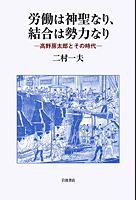
This is the English translation of the book Rôdô wa shinsei nari ketsugô wa seiryoku nari; Takano Fusatarô to sono jidai,(Iwanami Shoten Publishers, 2008.), Chapter 1. Bunmeikaika no ko - Nagasaki jidai
|